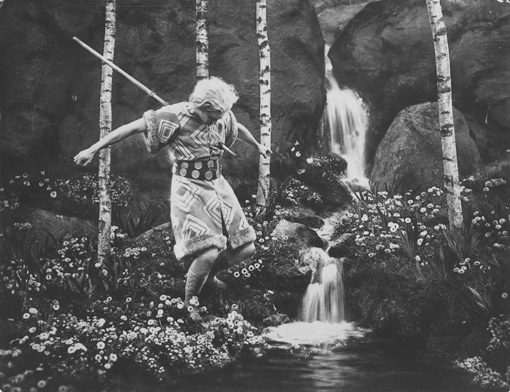2012. GB. DVD + Blu-ray. Eureka (Masters of Cinema series). 288 minutes + extras. £19.99
 About the author: Dr Paul Cuff is an Associate Fellow in the Department of Film and Television at the University of Warwick. He has written an article on Abel Gance’s La Roue (1922) (published in Film History) and has work awaiting publication on J’accuse! (1919) and Napoléon (1927), two films from the same director.
E-mail: paul.cuff@warwick.ac.uk
About the author: Dr Paul Cuff is an Associate Fellow in the Department of Film and Television at the University of Warwick. He has written an article on Abel Gance’s La Roue (1922) (published in Film History) and has work awaiting publication on J’accuse! (1919) and Napoléon (1927), two films from the same director.
E-mail: paul.cuff@warwick.ac.uk
Fritz Lang’s epic masterpiece Die Nibelungen (1924) is one of the treasures of silent cinema. Based on the same German legends that inspired Wagner’s 'Ring Cycle', this five-hour film is divided into two parts. The first, Siegfried, depicts the eponymous youth in search of adventure. Siegfried (Paul Richter) slays a dragon and becomes invincible by bathing in its blood – but a leaf that lands on his shoulder leaves him with a fatal weakness. Though he finds success and riches, his complex allegiance with the Nibelung clan breaks down amid greed and treachery – he is betrayed and murdered whilst on a hunt. Visually, Siegfried is as precisely designed as its narrative: every detail of the sets, lighting, and costumes is impeccably organized. Lang’s vast production created some of the most iconic images of silent German cinema: Siegfried riding through the sun-dappled forest (a maze of concrete columns rendered sublimely magical by lighting and colour tinting); his fight with the dragon (an immense mechanized model that breathes real fire), the bridge made from a hundred knights supporting a walkway of shields; Siegfried being pierced by a spear and falling to the ground, mortally wounded, amid a bed of trembling flowers.

The stately, majestic imagery of the first film gives way to the increasingly intense and chaotic style of Kriemhilds Rache, where Siegfried’s widow seeks to avenge his murder. Kriemhild (Margarete Schön) journeys to the East, where she forms an alliance with the Huns and King Etzel (Rudolf Klein-Rogge) and brings their army to bear on those who betrayed her husband. The thrillingly gloomy denouement of the film comes with Kriemhild’s vengeance reaching its inexorable conclusion: the heaped-up bodies of the slain herald a terrifying conflagration of a palace stronghold.
 Like many silent films, Die Nibelungen has been victim to all kinds of physical loss and damage over the decades. This new blu-ray release is the result of a lengthy restoration process by the Friedrich-Wilhelm-Murnau-Stiftung in Germany. Their impeccable work (detailed in an informative documentary included in this release) has produced what will likely remain the most authentic version of Die Nibelungen seen since 1924. The remarkable sharpness and depth of the image (complete with its original colour tinting) is hypnotically lustrous – this is as close as most viewers can get to the original 35mm celluloid. Eureka’s release preserves the written intertitles in their original German (a courtesy that other labels often deny foreign-language films) and the graphic impact of their gothic font is the perfect match for the visual design of Lang’s imagery. Also of importance is the music used for this restoration. Only a very small percentage of contemporary scores for silent films survive at all, so it is a joy to hear the wonderfully atmospheric orchestral music of Gottfried Huppertz that accompanied Die Nibelungen on its original release.
Like many silent films, Die Nibelungen has been victim to all kinds of physical loss and damage over the decades. This new blu-ray release is the result of a lengthy restoration process by the Friedrich-Wilhelm-Murnau-Stiftung in Germany. Their impeccable work (detailed in an informative documentary included in this release) has produced what will likely remain the most authentic version of Die Nibelungen seen since 1924. The remarkable sharpness and depth of the image (complete with its original colour tinting) is hypnotically lustrous – this is as close as most viewers can get to the original 35mm celluloid. Eureka’s release preserves the written intertitles in their original German (a courtesy that other labels often deny foreign-language films) and the graphic impact of their gothic font is the perfect match for the visual design of Lang’s imagery. Also of importance is the music used for this restoration. Only a very small percentage of contemporary scores for silent films survive at all, so it is a joy to hear the wonderfully atmospheric orchestral music of Gottfried Huppertz that accompanied Die Nibelungen on its original release.
For students, this film offers a fascinating glimpse into the culture of the Weimar period
For students, this film offers a fascinating glimpse into the culture of the Weimar period and how UFA’s prestigious studio resurrected traditional German folktales for modern audiences. Die Nibelungen was not a great commercial success in 1924 and its reputation later garnered controversy when Siegfried was appropriated and rereleased by the Nazis in 1933. Significantly, they did not release the far more disturbing Kriemhilds Rache – Lang himself left Nazi Germany in 1934 and would always defend the value of his film as a vital retelling of a legendary past. This blu-ray edition (with its informative extras) represents a valuable opportunity to appreciate the power of Lang’s silent original, as well as understand its context in the culture of German national cinema and inter-war history. Die Nibelungen is without doubt one of the most important films of the 1920s, a dazzling example of expressionist technique and rich cinematic storytelling.
Dr Paul Cuff